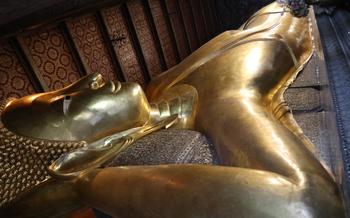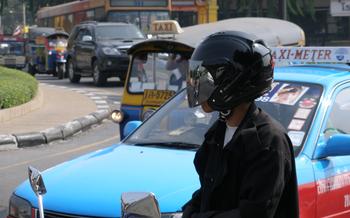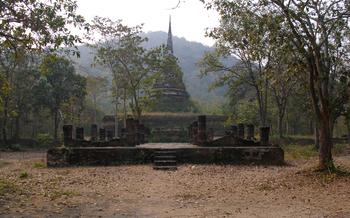
Wat Buppharam or Wat Plai Klong
- Wat Buppharam - A Historical Haven
- Exploring the Temple Grounds
- Local Cuisine and Flavors
- Cultural Performances and Events
- Shopping for Souvenirs
- Accommodation and Nearby Hotels
- Transportation and Getting There
- Tips:
- Visiting Hours and Dress Code
- Photography Tips
- Historical Anecdotes and Legends
- Off-the-Beaten-Path Gems
- Combining Temple Visits with Nature
- Insider Tip: Unveiling Hidden Gems and Unique Experiences
Wat Buppharam - A Historical Haven
Nestled in the heart of Trat, Thailand, Wat Buppharam stands as a testament to the region's rich history and religious heritage. Built in the 18th century, this ancient temple is a stunning example of Thai architecture and craftsmanship, featuring intricate carvings, colorful murals, and gleaming golden spires that reach towards the sky.
Wat Buppharam holds immense cultural significance for the local community. It is believed to have been built by a group of monks who settled in the area centuries ago, and its construction is attributed to the patronage of the royal family. The temple has undergone several renovations and expansions over the years, but its original beauty and charm have been carefully preserved.
The temple complex consists of several buildings, including the main ordination hall, a viharn or assembly hall, a chedi or stupa, and a bell tower. The ordination hall is the heart of the temple, where monks gather for daily prayers and ceremonies. Its interior is adorned with intricate murals depicting scenes from the life of Buddha and Thai folklore, while the exterior features delicate carvings and bas-reliefs.
Wat Buppharam is not only a place of worship but also a center for community gatherings and cultural events. The temple hosts festivals and celebrations throughout the year, attracting both locals and visitors. During these events, the temple grounds come alive with music, dance, and traditional Thai cuisine, offering a glimpse into the vibrant culture of Trat.
Exploring the Temple Grounds
The temple complexes of Wat Buppharam and Wat Plai Klong offer a rich and immersive experience for visitors seeking spiritual enlightenment and cultural immersion. As you wander through the grounds, take note of the intricate layout, which reflects traditional Thai architecture and design principles. Admire the well-preserved structures, including the main prayer halls, ordination halls, and bell towers, each adorned with intricate carvings, colorful murals, and gleaming spires.
Within the temple grounds, discover notable features that hold significant religious and cultural meaning. Observe the Buddha images enshrined in various postures, exuding serenity and compassion. Gaze upon the vibrant murals that depict scenes from the life of Buddha and Thai mythology, providing a glimpse into the country's rich storytelling tradition. Don't miss the impressive chedis, or stupas, which serve as monuments to revered monks or religious figures and symbolize the Buddha's teachings.
Exploring the temple grounds is not just a journey of discovery but also an opportunity for introspection and contemplation. Immerse yourself in the tranquil atmosphere, where the gentle chanting of monks and the sound of prayer bells create a serene ambiance. Take a moment to sit in meditation or simply wander mindfully, appreciating the peace and tranquility that emanate from these sacred spaces.
Local Cuisine and Flavors
Trat offers a culinary journey that is as diverse and vibrant as its temples. The province is renowned for its fresh seafood, tropical fruits, and unique local delicacies. Visitors must indulge in the must-try seafood dishes, such as pla tuu (steamed crab), kung saeb (shrimp with tamarind sauce), and pla kapong nueng manao (steamed sea bass with lime and chili). These dishes showcase the bounty of the sea and the culinary expertise of Trat's chefs.
For a taste of local flavors, Khanom chin nam ya (rice noodles with southern-style curry), laap pla too (spicy fish salad), and kaeng som chaom (sour soup with fish and vegetables) are must-try dishes. These dishes are a harmonious blend of sweet, sour, and spicy flavors, reflecting the culinary heritage of the region.
To enhance the culinary experience, visitors can explore the local markets and street food vendors near the temples. These vibrant marketplaces offer a plethora of fresh produce, local specialties, and handmade snacks. Visitors can savor the aromas and flavors of khanom krok (coconut pancakes), roti sai mai (stuffed roti), and tub tim krob (water chestnuts in sweet syrup), among many other delicacies.
For vegetarians and those with dietary restrictions, Trat offers a variety of options. Many local restaurants cater to vegetarian and vegan preferences, offering dishes such as pad pak boong (stir-fried morning glory), tomyum hed (mushroom soup), and khao pad sapparot (pineapple fried rice). Visitors can also find a variety of fresh fruits and vegetables in the local markets, making it easy to create healthy and nutritious meals.
Cultural Performances and Events
Cultural performances and events in Trat offer a vibrant immersion into the region's rich heritage and traditions. At both Wat Buppharam and Wat Plai Klong, visitors can witness traditional Thai dance performances that showcase the grace and elegance of Thai culture. These performances often take place during festivals and special occasions, providing a unique opportunity to experience the local artistry.
Must-Attend Festivals:
-
Trat Seafood Festival: Held annually in March, this festival celebrates the region's bountiful seafood harvests with cooking competitions, seafood markets, and cultural performances.
-
Songkran Festival: The Thai New Year, celebrated in April, features water-throwing ceremonies, parades, and merit-making activities at temples.
Tips for Attending Cultural Events:
-
Check temple schedules or tourist information centers for upcoming events and performances.
-
Arrive early to secure a good spot, as these events often draw large crowds.
-
Dress respectfully, covering shoulders and knees, and remove shoes before entering temples.
-
Be mindful of local customs, such as not touching monks or pointing your feet at Buddha images.
-
Enjoy the performances and participate in the festivities, but remember to be respectful of others.
Shopping for Souvenirs
When exploring the area around Wat Buppharam and Wat Plai Klong, you'll find a variety of local markets and shops offering unique handicrafts, souvenirs, and religious artifacts. These markets are a great place to find handmade crafts, such as woven baskets, pottery, and wood carvings. You can also find souvenirs related to the temples, such as Buddha images, amulets, and replicas of the temples themselves.
Bargaining is a common practice in Thailand, so don't be afraid to negotiate prices with the vendors. However, be respectful and remember that the vendors are often making a living from their sales. Supporting local artisans and the community by purchasing souvenirs from them is a great way to show your appreciation for their work and help preserve traditional Thai crafts.
When shopping for souvenirs, it's important to be mindful of cultural norms and customs. Avoid purchasing items that are made from endangered or protected species, and be respectful of religious artifacts. By shopping responsibly and respectfully, you can help ensure that the local markets and shops remain a vibrant part of the community.
Accommodation and Nearby Hotels
When planning your visit to Wat Buppharam and Wat Plai Klong, you'll want to consider your accommodation options. Trat offers a range of choices to suit different budgets and preferences. For a comfortable and convenient stay, several hotels and guesthouses are located within walking distance of the temples. These range from budget-friendly options to mid-range hotels with amenities like swimming pools and restaurants.
If you prefer a more immersive experience, consider staying at a local homestay. This offers a chance to connect with the community and experience traditional Thai hospitality. Homestays typically provide basic amenities and a glimpse into the daily lives of local people.
For those seeking luxury and exclusivity, Trat also has a selection of high-end resorts and villas. These offer stunning views, private pools, and top-notch amenities. While they may be further from the temples, they provide a peaceful and tranquil retreat after a day of exploration.
To find the best deals and make reservations, consider booking online or through a travel agent. Be sure to check for discounts and promotions, especially during the off-season. It's also a good idea to book in advance, particularly if you're visiting during peak tourist season.
Transportation and Getting There
Visiting Wat Buppharam and Wat Plai Klong is easy, with various transportation options available. Public buses provide a convenient and affordable way to reach the temples from Trat city center. The journey takes approximately 30 minutes, and buses depart regularly throughout the day. Taxis and tuk-tuks are also readily available, offering a more personalized and direct mode of transportation. However, negotiating fares is essential to ensure a fair price.
For those seeking a more active and immersive experience, cycling or motorbike rentals are excellent options. Trat offers beautiful countryside roads, making cycling a delightful way to explore the temples and the surrounding area. Motorbike rentals provide greater flexibility and allow visitors to venture further into the province.
Tips:
- Plan your route in advance to avoid getting lost or wasting time.
- If taking a taxi or tuk-tuk, agree on a fare before getting in to prevent disputes.
- Consider renting a bicycle or motorbike for a more adventurous and independent experience.
- Allow ample time for transportation, especially if combining temple visits with other activities.
- Be prepared for limited public transportation options during peak tourist season or on holidays.
Visiting Hours and Dress Code
Wat Buppharam and Wat Plai Klong welcome visitors every day of the week. Wat Buppharam opens from 8:00 AM to 6:00 PM, while Wat Plai Klong opens from 8:00 AM to 5:00 PM. Both temples charge a modest admission fee of 20 THB (approximately 0.65 USD) for foreign visitors.
When visiting temples in Thailand, it is important to dress respectfully. Shoulders and knees should be covered, and revealing clothing is not appropriate. Visitors can bring their own shawls or sarongs to cover up if needed. It is also customary to remove shoes before entering the temple grounds.
To avoid peak tourist hours and crowds, it is best to visit the temples early in the morning or late in the afternoon. This will allow you to enjoy a more peaceful and serene experience.
Photography Tips
Visiting Wat Buppharam and Wat Plai Klong offers ample opportunities for photography enthusiasts to capture the beauty and serenity of these sacred spaces. Here are some tips to help you take stunning photos:
-
Respectful Approach: Always seek permission before taking photos, especially if there are monks or ceremonies taking place. Be mindful of not disturbing the religious atmosphere.
-
Natural Light: Make the most of the natural light, especially during the golden hours of sunrise and sunset. The soft, warm light enhances the colors and textures of the temple architecture.
-
Composition: Experiment with different angles and perspectives to create dynamic compositions. Capture the grandeur of the temple structures against the vast sky or focus on intricate details like sculptures or murals.
-
Respect Privacy: Be respectful of other visitors and monks by avoiding taking photos that might invade their privacy. Ask for permission if you wish to photograph individuals.
-
Flash Etiquette: Avoid using flash photography inside the temples, as it can be disruptive and damaging to delicate artifacts. Natural light or low-light photography techniques are preferred.
Historical Anecdotes and Legends
Wat Buppharam is steeped in rich history and captivating legends. One intriguing tale revolves around the temple's founding. According to local folklore, a group of villagers discovered a glowing orb emitting a mysterious light. Believing it to be a sacred sign, they constructed a small shrine on the spot where the orb was found. Over time, the shrine grew into the magnificent temple that stands today.
Another captivating legend associated with Wat Buppharam is the story of the Emerald Buddha. It is said that the temple was once home to this revered Buddha image, which is considered one of the most sacred relics in Thailand. However, during a period of unrest, the Emerald Buddha was taken from the temple and moved to its current location at the Grand Palace in Bangkok.
Wat Plai Klong also holds its own share of intriguing stories. One popular legend tells of a giant catfish that once inhabited the temple's pond. According to local belief, the catfish was a guardian spirit that protected the temple and its surroundings. It is said that the catfish would often appear to people in their dreams and offer guidance and protection.
These historical anecdotes and legends add a layer of enchantment to the temples of Wat Buppharam and Wat Plai Klong. They provide a glimpse into the rich cultural heritage of Trat and the deep spiritual beliefs of the Thai people.
Off-the-Beaten-Path Gems
While Wat Buppharam and Wat Plai Klong are undoubtedly remarkable, Trat boasts a wealth of lesser-known temples and religious sites that offer a glimpse into the region's rich spiritual heritage. For those seeking a more intimate and authentic experience, exploring these hidden gems is highly recommended.
One such temple is Wat Hin Mak Peng, located in a serene setting amidst rolling hills. This ancient temple features a large reclining Buddha statue carved into a natural rock formation, creating a unique and awe-inspiring sight. Visitors can pay their respects and soak in the tranquil atmosphere of this hidden sanctuary.
Another off-the-beaten-path gem is Wat Khao Saming, nestled atop a hill overlooking the Trat River. This temple is renowned for its stunning panoramic views of the surrounding landscape. Visitors can climb the steps to the temple, explore the serene grounds, and enjoy the breathtaking vistas.
To discover these hidden gems, consider renting a motorbike or bicycle and venturing into the surrounding countryside. This allows for a more immersive and flexible exploration of Trat's religious and cultural treasures. Local guides can also be hired to provide insights and lead visitors to lesser-known temples that may not be easily accessible on one's own.
By exploring these off-the-beaten-path temples, visitors can gain a deeper understanding of Trat's diverse religious traditions and experience the authentic spiritual atmosphere that permeates the region.
Combining Temple Visits with Nature
While exploring the sacred spaces of Wat Buppharam and Wat Plai Klong, visitors can venture beyond the temple grounds and immerse themselves in the natural beauty of Trat. The province boasts stunning landscapes, inviting travelers to combine their spiritual journey with outdoor adventures.
A short drive from the temples leads to Khao Sam Roi Yot National Park, renowned for its majestic limestone mountains, lush forests, and pristine beaches. Visitors can embark on hiking trails, explore hidden caves, and witness spectacular views from the park's viewpoints.
For those seeking a more aquatic experience, Trat offers numerous opportunities for kayaking and snorkeling. The crystal-clear waters of the Gulf of Thailand are home to vibrant coral reefs, teeming with diverse marine life. Paddling through the tranquil waters while surrounded by stunning scenery creates a truly unforgettable experience.
Combining temple visits with nature excursions allows travelers to gain a deeper appreciation for the harmony between spirituality and the environment in Trat. Whether hiking through lush forests, kayaking amidst coral reefs, or simply relaxing on a secluded beach, visitors can create a well-rounded itinerary that caters to both their spiritual and adventurous sides.
Insider Tip: Unveiling Hidden Gems and Unique Experiences
Beyond the main attractions, Wat Buppharam and Wat Plai Klong hold secret spots and unique experiences that are often missed by visitors. In Wat Buppharam, discover the hidden chamber behind the main Buddha image, where sacred relics and ancient murals are enshrined. At Wat Plai Klong, participate in the temple's fish feeding ceremony, an auspicious ritual that brings good fortune and blessings. For an authentic cultural immersion, join the local community during temple fairs or festivals, where you can witness traditional Thai dance performances, savor delicious local cuisine, and engage with the friendly locals. Embrace the opportunity to learn about Thai culture and make meaningful connections during these vibrant celebrations.




